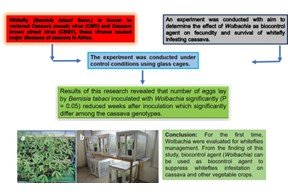Effect of Wolbachia as biocontrol agent on fecundity and survival of cassava whitefly in northwest Nigeria
Abstract
Whitefly (Bemisia tabaci Genn.) is known to vectored Cassava mosaic virus (CMV) and Cassava brown streak virus (CBSV), these viruses caused major diseases of cassava in Africa. An experiment was conducted to determine the effect of Wolbachia as biocontrol agent on fecundity and survival of whitefly infesting cassava. Whiteflies infesting cassava were captured and reared using rearing cages. Wolbachia was isolated from infected cassava whiteflies, cultured and used for the inoculations. The experiment was conducted under control conditions using glass cages. Results of this research revealed that number of eggs lay by Bemisia tabaci inoculated with Wolbachia significantly (P = 0.05) reduced weeks after inoculation which significantly differ among the cassava genotypes. Number of eggs lay by B. tabaci free of Wolbachia was significantly higher (964.35) than those inoculated with Wolbachia (46.541) at 4 weeks after inoculation (4WAI). The genotype ‘Dan Aliero’ had the highest number (4WAI 82.33), while, ‘Farin rogo’ had the lowest number of eggs (4WAI 23.33). Number of whitefly nymphs and adults also significantly reduced when B. tabaci was inoculated with Wolbachia. ‘Dan Aliero’ had the highest number of whitefly nymphs and adults (4WAI = 59.00) and (4WAI = 51.00), respectively. ‘Farin rogo’ recorded the lowest number of whitefly nymphs (17.67) and adults (13.00) at 4WAI, respectively. For the first time, Wolbachia were evaluated for whiteflies
management. From the finding of this study, Wolbachia can be used as biocontrol agent to suppress whiteflies infestation on cassava and other vegetable crops.
Keywords:
Biocontrol, Cassava, Dan Aliero, Farin rogo, Whitefly, WolbachiaDownloads
References
Albajes, R., Sarasúa, M. J., Avilla, J., Arnó, J., & Gabarra, R. (2003). Integrated pest management in a Mediterranean region: the case of Catalonia. In Integrated Pest Management in the Global Arena, ed. KM Maredia, D Dakouo, D Mota-Sánchez, pp. 341–355. Oxon, UK: CABI Publishing.
Brelsfoard, C. L., & Dobson, S. L. (2009). Wolbachia-based strategies to control insect pests and disease vectors. Asia Pacific Journal of Molecular Biology and Biotechnology, 17(3), 55-63
FAOSTAT. (2020). FAOSTAT. Food and Agriculture Organization of the United Nations, Rome, Italy. http://faostat.fao.org/site/ 567/default.aspx
Frydman, H. M. (2006). Isolation of live bacteria from adult insects. Research Square, https//doi.org/10.1038/nprot.2006.131
Greenberg, S. M., Jones, W. A., Liu, & Xian, T. (2009). Tritrophic interactions among host plants, whiteflies and parasitoids. Southwestern Entomology, 34, 431-445.
Hilgenboecker, K., Hammerstein, P., Schlattmann, P., Telschow, A., & Werren, J. H. (2008). How many species are infected with Wolbachia? – a statistical analysis of current data. FEMS Microbiology Letters, 2, 215–220.
Marubayashi, J. M., Kliot, A., Yuki, V. A., Rezende, J. A. M., Krause-Sakate, R., Pavan, M. A., & Ghanim, M. (2014). Diversity and localization of bacterial endosymbionts from whitefly species collected from Brazil. PlosOne, 9(9), e108363
McMenima, C. J., & O’Neill, S. L. (2010). A virulent Wolbachia infection decrease the viability of the dengue vector Aedes aegypti during periods of embryonic quiescence. Plos Neglected Tropical Diseases, 4(7), p. e748
Polston, J. E., De Barro, P., & Boykin, L. M. (2014). Transmission specificities of plant viruses with the newly identified species of the Bemisia tabaci species complex. Pest Management Science, 70(10), 1547-1552.
Prasannakumar, N. R., & Maruthi, M. N. (2021). Understanding the interactions among the crop plants, a virus, insect vector whiteflies and their endosymbionts. Phytoparasitica, 49,739-750.
Rao, Q., Rollat-Farnier, P. A., Zhu, D. T., Santos-Garcia, D., Silva, F. J., Moya, A., Latorre, A., Klein, C. C., Vavre, F., & Sagot, M. F. (2015). Genome reduction and potential metabolic complementation of the dual endosymbionts in the whitefly (Bemisia tabaci). BMC Genomics, 16(1), 226
Werren, J. H., Baldo, L., & Clark, M. E. (2008). Wolbachia: master manipulators of invertebrate biology. Nature Reviews Microbiology, 6, 741–751.

Published
How to Cite
Issue
Section
Copyright (c) 2023 Agriculture and Environmental Science Academy

This work is licensed under a Creative Commons Attribution-NonCommercial 4.0 International License.

